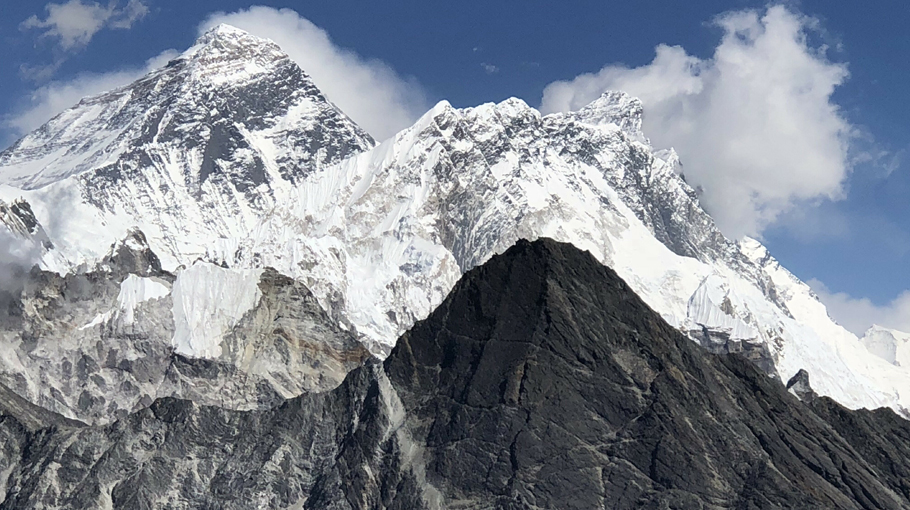Then and now: 70 years of Everest

Seventy years ago, New Zealander Edmund Hillary and Nepali Tenzing Norgay Sherpa became the first humans to summit Everest on May 29, 1953.
The British expedition made the two men household names around the world and
changed mountaineering forever.
Hundreds now climb the 8,849-metre (29,032-foot) peak every year, fuelling
concerns of overcrowding and pollution on the mountain. AFP looks at the evolution of the Everest phenomenon.
What is the mountain called?
Initially known only to British mapmakers as Peak XV, the mountain was
identified as the world's highest point in the 1850s and renamed in 1865
after Sir George Everest, a former Surveyor General of India.
On the border of Nepal and China and climbable from both sides, it is called
Chomolungma or Qomolangma in Sherpa and Tibetan -- "goddess mother of the
world" -- and Sagarmatha in Nepali, meaning "peak of the sky".
How has climbing Everest changed?
The 1953 expedition was the ninth attempt on the summit and it took 20 years
for the first 600 people to climb it. Now that number can be expected in a
single season, with climbers catered to by experienced guides and commercial
expedition companies.
The months-long journey to the base camp was cut to eight days with the
construction of a small mountain airstrip in 1964 in the town of Lukla, the
gateway to the Everest region.
Gear is lighter, oxygen supplies are more readily available, and tracking
devices make expeditions safer. Climbers today can summon a helicopter in
case of emergency.
Every season, experienced Nepali guides set the route all the way to the
summit for paying clients to follow.
But Billi Bierling of Himalayan Database, an archive of mountaineering
expeditions, said some things remain similar: "They didn't go to the
mountains much different than we do now. The Sherpas carried everything. The
expedition style itself hasn't changed."
What is base camp like?
The starting point for climbs proper, Everest Base Camp was once little more
than a collection of tents at 5,364 metres (17,598 feet), where climbers
lived off canned foods.
Now fresh salads, baked goods and trendy coffee are available, with crackly
conversations over bulky satellite phones replaced by wifi and Instagram
posts.
How does the news of a summit travel?
Hillary and Tenzing summited Everest on May 29 but it only appeared in
newspapers on June 2, the day of Queen Elizabeth's coronation: the news had
to be brought down the mountain on foot to a telegraph station in the town of
Namche Bazaar, to be relayed to the British Embassy in Kathmandu.
In 2011, British climber Kenton Cool tweeted from the summit with a 3G signal
after his ninth successful ascent. More usually, walkie-talkie radios are
standard expedition equipment and summiteers contact their base camp teams,
who swiftly post on social media.
In 2020, China announced 5G connectivity at the Everest summit.
What are the effects of climate change?
Warming temperatures are slowly widening crevasses on the mountain and
bringing running water to previously snowy slopes.
A 2018 study of Everest's Khumbu glacier indicated it was vulnerable to even
minor atmospheric warming, with the temperature of shallow ice already close
to melting point.
"The future of the Khumbu icefall is bleak," its principal investigator,
glaciologist Duncan Quincey, told AFP. "The striking difference is the
meltwater on the surface of the glaciers."
Three Nepali guides were killed on the formation this year when a chunk of
falling glacial ice swept them into a deep crevasse.
It has become a popular cause for climbers to highlight, and expedition
companies are starting to implement eco-friendly practices at their camps,
such as solar power.
What is the impact of social media?
Click, post, repeat -- the climbing season plays out on social media as
excited mountaineers document their journey to Everest on Facebook, Instagram
and other social media platforms.
Hashtags keep their sponsors happy and the posts can catch the eyes of
potential funders.
That applies to both foreign climbers and their now tech-savvy Nepali guides.
"Everyone posts nowadays, it is part of how we share and build our profile,"
said Lakpa Dendi Sherpa, who has summited Everest multiple times and has
62,000 Instagram followers.
Mountain of records?
Veteran Nepali guides Kami Rita Sherpa and Pasang Dawa Sherpa both scaled
Everest twice this season, with the latter twice matching the former's record
number of summits before Kami Rita reclaimed pole position with 28.
There are multiple Everest record categories for first and fastest feats of
endurance.
But some precedents are more quixotic: in 2018, a team of British climbers,
an Australian and a Nepali dressed in tuxedos and gowns for the world's
highest dinner party at 7,056 metres on the mountain's Chinese side.



